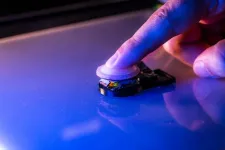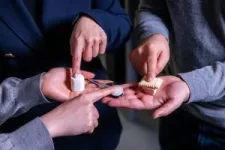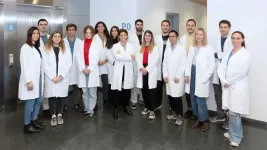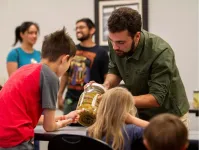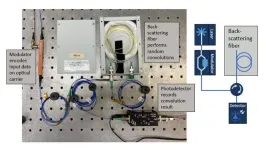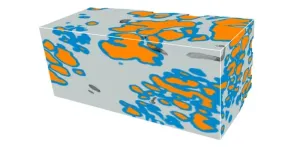(Press-News.org) The perception of softness can be taken for granted, but it plays a crucial role in many actions and interactions – from judging the ripeness of an avocado to conducting a medical exam, or holding the hand of a loved one. But understanding and reproducing softness perception is challenging, because it involves so many sensory and cognitive processes.
Robotics researchers have tried to address this challenge with haptic devices, but previous attempts have not distinguished between two primary elements of softness perception: cutaneous cues (sensory feedback from the skin of the fingertip), and kinesthetic cues (feedback about the amount of force on the finger joint).
“If you press on a marshmallow with your fingertip, it’s easy to tell that it’s soft. But if you place a hard biscuit on top of that marshmallow and press again, you can still tell that the soft marshmallow is underneath, even though your fingertip is touching a hard surface,” explains Mustafa Mete, a PhD student in the Reconfigurable Robotics Lab in the School of Engineering. “We wanted to see if we could create a robotic platform that can do the same.”
With SORI (Softness Rendering Interface), the RRL, led by Jamie Paik, has achieved just that. By decoupling cutaneous and kinesthetic cues, SORI faithfully recreate the softness of a range of real materials, filling a gap in the robotics field enabling many applications where softness sensation is critical – from deep-sea exploration to robot-assisted surgery.
The research appears in the Proceedings of the National Academy of Science (PNAS).
We all feel softness differently
Mete explains that neuroscientific and psychological studies show that cutaneous cues are largely based on how much skin is in contact with a surface, which is often related in part to the deformation of the object. In other words, a surface that envelopes a greater area of your fingertip will be perceived as softer. But because human fingertips vary widely in size and firmness, one finger may make greater contact with a given surface than another.
“We realized that the softness I feel may not be the same as the softness you feel, because of our different finger shapes. So, for our study, we first had to develop parameters for the geometries of a fingertip and its contact surface in order to estimate the softness cues for that fingertip,” Mete explains. Then, the researchers extracted the softness parameters from a range of different materials, and mapped both sets of parameters onto the SORI device.
Building on the RRL’s trademark origami robot research, which has fueled spinoffs for reconfigurable environments and a haptic joystick, SORI is equipped with motor-driven origami joints that can be modulated to become stiffer or more supple. Perched atop the joints is a dimpled silicone membrane. A flow of air inflates the membrane to varying degrees, to envelop a fingertip placed at its center.
With this novel decoupling of kinesthetic and cutaneous functionality, SORI succeeded in recreating the softness of a range of materials – including beef, salmon, and marshmallow – over the course of several experiments with two human volunteers. It also mimicked materials with both soft and firm attributes (such as a biscuit on top of a marshmallow, or a leather-bound book). In one virtual experiment, SORI even reproduced the sensation of a beating heart, to demonstrate its efficacy at rendering soft materials in motion.
Medicine is therefore a primary area of potential application for this technology; for example, to train medical students to detect cancerous tumors, or to provide crucial sensory feedback to surgeons using robots to perform operations.
Other applications include robot-assisted exploration of space or the deep ocean, where the device could enable scientists to feel the softness of a discovered object from a remote location. SORI is also a potential answer to one of the biggest challenges in robot-assisted agriculture: harvesting tender fruits and vegetables without crushing them.
“This is not intended to act as a softness sensor for robots, but to transfer the feeling of ‘touch’ digitally, just like sending photos or music,” Mete summarizes.
END
Robotic interface masters a soft touch
EPFL researchers have developed a haptic device capable of reproducing the softness of various materials, from a marshmallow to a beating heart, overcoming a deceptively complex challenge that has previously eluded roboticists
2024-03-11
ELSE PRESS RELEASES FROM THIS DATE:
Tuberculosis bacteria also present in 90% of those with symptoms, who are not diagnosed with TB
2024-03-11
Mycobacterium tuberculosis (Mtb), the bacteria that causes a tuberculosis infection, is present in exhaled breath of 90% of those presenting with suspected tuberculosis. This includes those who were negative on conventional sputum testing and not diagnosed with TB. This raises the possibility that those who have tested negative may be unknowingly transmitting the infection. Researchers from the University of Cape Town and Amsterdam UMC analysed results from over 100 patients who presented themselves to clinics in South Africa. These findings are published today in PNAS.
“If ...
U of M-led study reveals shared blueprint in brain development across different functional areas
2024-03-11
In a new study published in Proceedings of the National Academy of Sciences (PNAS), researchers from the University of Minnesota Medical School investigated brain development to understand how different areas of the brain become specialized in handling information such as vision, sound, touch and planning.
The study found that different areas of the brain start with a similar organization rather than already being specialized in early development. This suggests that the brain might use a single shared blueprint to guide early development.
“Throughout life, the brain continually builds on the foundations set ...
Researchers solve crucial cold-induced sweetening problem in potato production
2024-03-11
Researchers have discovered a game changer for the potato industry.
According to a new study published in a leading international society journal published by the American Society of Plant Biologists, a small genetic element is the cause of a major production problem in potatoes.
“Our manuscript reveals the mystery of “cold-induced sweetening” (CIS), the most troublesome and expensive problem for the potato processing industry,” explained Jiming Jiang, Corresponding Author of “Molecular dissection of an intronic enhancer governing cold-induced expression ...
Developed by VHIO, a novel AI-based and non-invasive diagnostic tool enables accurate brain tumor diagnosis, outperforming current classification methods
2024-03-11
Developed by VHIO, a novel AI-based and non-invasive diagnostic tool enables accurate brain tumor diagnosis, outperforming current classification methods
Developed by VHIO’s Radiomics Group in close collaboration with researchers of the Neuroradiology Unit at the Bellvitge University Hospital (HUB), DISCERN is a deep learning tool that leverages information of magnetic resonance imaging and facilitates brain tumor classification to aid clinical decision making.
Currently, a definitive diagnosis often requires neurosurgical interventions that compromise the quality of life of patients.
Trained to differentiate between the three most ...
Natural history specimens have never been so accessible
2024-03-11
With the help of 16 grants from the National Science Foundation, researchers have painstakingly taken computed topography (CT) scans of more than 13,000 individual specimens to create 3D images of more than half of all the world's animal groups, including mammals, fishes, amphibians and reptiles.
The research team, made of members from The University of Texas at Arlington and 25 other institutions, are now a quarter of the way through inputting nearly 30,000 media files to the open-source repository MorphoSource. This will allow researchers ...
NRL research physicists explore fiber optic computing using distributed feedback
2024-03-11
WASHINGTON – U.S. Naval Research Laboratory (NRL) researchers deliver novel contribution in fiber optics computing, Fiber Optic Computing Using Distributed Feedback paper recently published in Communications Physics journal, brings the Navy one step closer to faster, more efficient computing technologies.
Optical computing uses the properties of light, such as its speed and ability to carry large amounts of data, to process information more efficiently than traditional electronic computers.
In collaboration with Sandia National Laboratories and the University of Central Florida, NRL is aiming ...
Canals used to drain peatlands are underappreciated hotspots for carbon emissions
2024-03-11
A new study led by UC San Diego Scripps Institution of Oceanography postdoctoral scholar Jennifer Bowen finds that canals used to drain soggy peatlands in Southeast Asia are likely hotspots for greenhouse gas emissions.
The results, published March 8 in Nature Geoscience and supported by the Scripps Institutional Postdoctoral Program and Stanford University’s Precourt Institute for Energy, identify a previously unaccounted for source of emissions from these threatened, carbon-rich landscapes. Findings from the study suggest that the degradation of tropical peatlands in Southeast Asia has released even more planet-warming ...
Nutritional value of meat should be considered when comparing carbon footprints
2024-03-11
The nutritional value of meat must be considered when comparing carbon footprints – that is the key message from a recent study undertaken by Hybu Cig Cymru – Meat Promotion Wales (HCC), Bangor University, Queen’s University, and the Agri-Food and Biosciences Institute (AFBI).
The scientific paper, published in the journal Frontiers in Sustainable Food Systems using data from the Welsh Lamb Meat Quality project, focuses on different lamb production systems, specifically the ‘finishing’ period – at the end of which lambs have reached the required weight, meat and fat cover for ...
Microscopy plus deep learning to advance prostate cancer diagnosis
2024-03-11
Prostate cancer stands as a prevalent threat to men's health, ranking second in cancer-related deaths in the United States. Each year, approximately 250,000 men in the U.S. receive a prostate cancer diagnosis. While most cases have low morbidity and mortality rates, a subset of cases demands aggressive treatment. Urologists assess the need for such treatment primarily through the Gleason score, which evaluates prostate gland appearance on histology slides. However, there's considerable variability in interpretation, leading to both undertreatment and overtreatment.
The current method, based on histology ...
Cancer researchers awarded $3.2 million grant to find better ways to treat advanced melanoma
2024-03-11
A team of investigators from the UCLA Health Jonsson Comprehensive Cancer and the University of Arkansas for Medical Sciences (UAMS) Winthrop P. Rockefeller Cancer Institute was awarded a $3.2 million grant from the National Institutes of Health to identify new ways to prevent and overcome treatment resistance to targeted therapy in patients with all sub-types of cutaneous melanoma, an aggressive form of skin cancer.
Virtually all cutaneous melanomas display genetic alterations that ...
LAST 30 PRESS RELEASES:
New modeling approach sheds light on rare gut disease
Study documents potentially hazardous flame retardants in firefighter gear
Can certain bacteria regulate aging of the immune system and its related alterations?
AI model helps diagnose often undetected heart disease from simple EKG
There are fewer online trolls than people think
Cell membrane fluctuations produce electricity
Jeonbuk National University study shows positive parenting can protect adolescents against self-harm
Surface-engineered ZnO nanocrystals to tackle perfluoroalkyl substance contamination
This new understanding of T cell receptors may improve cancer immunotherapies
A new fossil face sheds light on early migrations of ancient human ancestor
A new immunotherapy approach could work for many types of cancer
A new way to diagnose deadly lung infections and save lives
40 percent of MRI signals do not correspond to actual brain activity
How brain-inspired algorithms could drive down AI energy costs
Gum disease may be linked to plaque buildup in arteries, higher risk of major CVD events
Contrails are a major driver of aviation’s climate impact
Structure of dopamine-releasing neurons relates to the type of circuits they form for smell-processing
Reducing social isolation protects the brain in later life
Keeping the heart healthy increases longevity even after cancer
Young adults commonly mix cannabis with nicotine and tobacco
Comprehensive review illuminates tau protein's dual nature in brain health, disease, and emerging psychiatric connections
Book prepares K-12 leaders for the next public health crisis
Storms in the Southern Ocean mitigates global warming
Seals on the move: Research reveals key data for offshore development and international ecology
Sports injuries sustained during your period might be more severe
World's first successful 2 Tbit/s free-space optical communication using small optical terminals mountable on satellites and HAPS
Can intimate relationships affect your heart? New study says ‘yes’
Scalable and healable gradient textiles for multi‑scenario radiative cooling via bicomponent blow spinning
Research shows informed traders never let a good climate crisis go to waste
Intelligent XGBoost framework enhances asphalt pavement skid resistance assessment
[Press-News.org] Robotic interface masters a soft touchEPFL researchers have developed a haptic device capable of reproducing the softness of various materials, from a marshmallow to a beating heart, overcoming a deceptively complex challenge that has previously eluded roboticists
